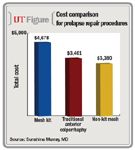Article
Hand-cut mesh beats kits, colporrhaphy on cost alone
If you're just considering cost effectiveness, not necessarily results, hand-cut mesh repair for anterior vaginal prolapse repair beats mesh kit repair and traditional colporrhaphy.
Dallas-If you're just considering cost effectiveness, not necessarily results, hand-cut mesh repair for anterior vaginal prolapse repair beats mesh kit repair and traditional colporrhaphy, an analysis from the University of Texas Southwestern Medical Center, Dallas indicates.
The researchers looked at the costs of the three types of procedures based on Medicare reimbursements for surgeon fees, office visits, and hospital costs of Soft Prolene mesh (Ethicon, Inc., Somerville, NJ) and mesh kits, operating room time, recovery room stay, intravenous fluids, and room and board. In addition, the investigators reviewed the literature to glean typical OR times, mesh extrusion rates, and recurrence rates for the procedures.

Steep supply cost for mesh kit
Using this model, the total cost was $4,678 for mesh kit repair, $3,461 for traditional anterior colporrhaphy, and $3,380 for non-kit mesh repair, reported first author Sunshine Murray, MD, the Felecia Cain fellow in pelvic medicine and reconstruction at UT Southwestern, who worked on the study with Gary Lemack, MD, and colleagues. Professional fees were higher for mesh repairs ($895 for both types) than traditional repair. What pushed the total cost higher for kit repair was the supply cost: $1,648 for mesh kit repair compared with $400 for non-kit mesh and $0 for the traditional repair.
When the team looked at cost outcomes based on various recurrence rates, they found that the recurrence rate for traditional repair would need to be less than 28% to be cost effective. Mesh kit repair did not reach cost effectiveness, even at an OR time of 0 minutes.
Pitting mesh repair against traditional repair and varying recurrence rates, the team found that if the non-kit mesh recurrence rate were just under 40%, traditional repair could remain cost effective if its recurrence rate remained less than 50%. On the other hand, if the recurrence rate for non-kit mesh were 0%, the recurrence rate for traditional repair would need to be about 12% to be cost equivalent. The mesh kit did not enter into the equation because of its supply cost.
Comparing extrusion rates with recurrence rates, the team found that if the extrusion rate with non-kit mesh were 0%, traditional repair would have to have a recurrence rate of about 20% to remain cost equivalent. (It was 30%.) On the other hand, if extrusion approached 50% with non-kit mesh repair, the traditional repair was cost effective if its recurrence rate was less than 38%.
"Mesh kits for anterior repair are not cost effective, regardless of the time saved in the operating room," Dr. Murray concluded. "Non-kit mesh is cost effective for anterior vaginal prolapse if the extrusion rates remain below 25%."
The analysis has limitations based on the assumptions made for it, Dr. Murray pointed out. For example, the team assumed that all extrusions and recurrences returned to the OR.
"We know that they don't all go back, but we did apply that to all three forms of repair," she said.
In addition, other complications-pain, sexual dysfunction, intraoperative bleeding, or injury-were not taken into account. Nor were the costs of other supplies or other procedures, such as hysterectomy, performed at the same time. Because this wasn't a prospectively designed study, the team didn't know if patients who had the different types of repairs used medical services differently.
Nevertheless, this is an important start for the kinds of analyses that surgeons need to do in addition to assessing clinical outcomes.
Newsletter
Stay current with the latest urology news and practice-changing insights — sign up now for the essential updates every urologist needs.
















